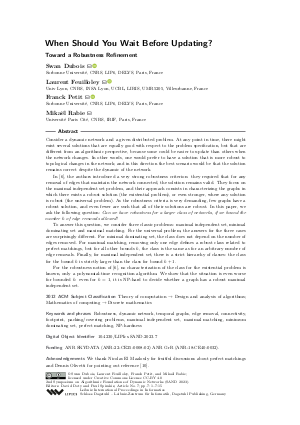@InProceedings{dubois_et_al:LIPIcs.SAND.2023.7,
author = {Dubois, Swan and Feuilloley, Laurent and Petit, Franck and Rabie, Mika\"{e}l},
title = {{When Should You Wait Before Updating? - Toward a Robustness Refinement}},
booktitle = {2nd Symposium on Algorithmic Foundations of Dynamic Networks (SAND 2023)},
pages = {7:1--7:15},
series = {Leibniz International Proceedings in Informatics (LIPIcs)},
ISBN = {978-3-95977-275-4},
ISSN = {1868-8969},
year = {2023},
volume = {257},
editor = {Doty, David and Spirakis, Paul},
publisher = {Schloss Dagstuhl -- Leibniz-Zentrum f{\"u}r Informatik},
address = {Dagstuhl, Germany},
URL = {https://drops.dagstuhl.de/entities/document/10.4230/LIPIcs.SAND.2023.7},
URN = {urn:nbn:de:0030-drops-179435},
doi = {10.4230/LIPIcs.SAND.2023.7},
annote = {Keywords: Robustness, dynamic network, temporal graphs, edge removal, connectivity, footprint, packing/covering problems, maximal independent set, maximal matching, minimum dominating set, perfect matching, NP-hardness}
}

 Creative Commons Attribution 4.0 International license
Creative Commons Attribution 4.0 International license






